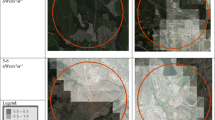Summary
-
1.
Locomotor activity in a group of ten captive reindeer (Rangifer tarandus L.) was recorded automatically during a 15-month period at the University of Ume\0a, Sweden (63\dg 49\t' N). The records were complemented by observations on activity and rumination in March, June, September and December. Artificial food was provided at lib.
-
2.
Reindeer have a polyphasic activity pattern with bursts occurring during both day and night.
The number of activity peaks varies from 4–6 in the winter with 6 h of daylight to 6–9 in the summer with continuous daylight. The increase in the number of activity peaks is brought about by a splitting of the evening activity peak, thereby creating an increasing number of peaks with gradually shorter frequencies.
-
3.
Sunrise and sunset act as \lssetpoints\rs for activity, separating it into a diurnal and a nocturnal phase. Since diurnal activity predominates, the reindeer is essentially a diurnal animal. Increasing daylength causes diurnal activity to increase in a 1:1 fashion while the ratio of night length to nocturnal activity is close to 1:0.5. This causes the total amount of activity over 24 h to change with photoperiod.
-
4.
Food consumption was about 30% lower in winter than in summer and varied in accordance with the changes in the activity pattern
-
5.
The time spent ruminating between meals was longer in winter than in summer, thus the winter activity pattern consisted of relatively few activity periods and long periods of rumination, unlike the summer pattern which was made up of large numbers of activity peaks with a shorter rumination time.
-
6.
Rumination showed a rhythmical pattern within the single resting period. Reindeer were found to perform one to several bouts of rumination, each lasting approximately 50 min.
-
7.
It is concluded that the activity pattern and the amount of activity is regulated mainly by changes in light-dark conditions. Photoperiod is presumed to provide the proximate factor governing the seasonal variations of energy intake in reindeer.
Similar content being viewed by others
References
Aschoff J (1962) Spontane lokomotorische Aktivität. Handbuch Zool 8:11 1–74
Aschoff J (1969) Phasenlage der Tagesperiodik in Abhängigkeit von Jahreszeit und Breitengrad. Oecologia (Berl) 3:125–165
Aschoff J, Wever R (1962) Beginn und Ende der täglichen Aktivität freilebender Vögel. J Ornithol 103:1–27
Bubenik AB (1960) The rythme nycthéméral et le régime journalier des ongulés sauvages. Mammalia 24:1–59
Daan S (1976) Light intensity and the timing of daily activity in finches. Ibis 118:223–235
Daan S, Aschoff J (1975) Circadian rhythms of locomotor activity in captive birds and mammals: Their variations with season and latitude. Oecologia (Berl) 18:269–316
Daan S, Slopsema S (1978) Short term rhythm in foraging behaviour of the common vole Microtus arvalis. J Comp Physiol 127:215–227
Eriksson L-O (1973) Spring inversion of the diel rhythm of locomotor activity in young sea-going brown trout. Salmo trutta trutta L., and Atlantic salmon, Salmo salar L. Aquilo Ser Zool 14:68–79
Erkinaro E (1969a) Der Phasenwechsel der lokomotorischen Aktivität bei Microtus agrestis (L), M. arvalis (Pall.) und M. oeconomus (Pall). Aquilo Ser Zool 8:1–31
Erkinaro E (1969b) Free-running circadian rhythm in Wood mouse (Apodemus flavicollis Melch.) under natural light-dark cycle. Experientia 25:649
Geertsema S, Reddinghaus J (1974) Preliminary considerations in the simulation of behaviour. In: Motivational control systems analysis. DJ McFarland, (ed). Academic Press NY pp 355–405
Jarman M, Jarman P (1973) Daily activity of impala. E Afr Wildl 11:75–92
Joubert E (1972) Activity patterns shown by mountain zebra, Equus zebra hartmannae in south west Africa with reference to climatic factors. Zool Apicane 8:309–331
McEwan EH (1968) Growth and development of the Barren-Ground Caribou. Can J Zool 46:1023–1029
McEwan EH, Whitehead PE (1970) Seasonal changes in the energy and nitrogen intake in reindeer and caribou. Can J Zool 48:902–912
Müller K (1969) Die Tages-und Jahresperiodik der Bachforelle (Salmo trutta L.) am Polarkreiz. Aquilo Ser Zool 8:50–62
Müller K (1973) Circadian rhythms of locomotor activity in aquatic organisms in the subarctic summer. Aquilo Ser Zool 14:1–18
Müller-Schwarze D, Källquist L, Mossing T (1979) Social behaviour and olfactory communication in reindeer (Rangifer t. tarandus L.). J Chem Ecol 5 (4):483–517
Ruiter L de, Weipkema PR, Reddinghaus J (1969) Ethological and nemological aspects of the regulation of food intake. Ann NY, Acad Sci 157:1204–1216
Scheibe K (1978) Das Zirkadianmuster der Aktivität von Schafen und seine Veränderung in künstliche Jahresregime. Biol Z Bl 97:329–336
Skogland T (1974) Villreinens habitatferd. Hardangervidda 1970–1973. Norsk IBP. Direktoratet for vilt og ferskvannfisk. Viltforskningen
Spinage CA (1968) A quantitative study of the daily activity of the Uganda defassa waterbuck. E Afr Wildl 6:89–93
Taylor J, Robinson D, Harker K (1955) Studies on the habit of zebu cattle. J Agri Sci 45:257–263
Thomson B (1973) Wild reindeer activity. Statens viltundersökelser. Direktoratet for jakt, viltstell og ferskvannsfiske. IBP. Trondheim
Turner DC (1978) Aktivitätsmuster freilebender Rhe im Verlauf des Frühjahrs: Optimale Ausnützung der Tageszeit. Rev Suisse Zool 85 (4) 710–718
Walther F (1973) Round-the-clock activity of Thomson gazelle (Gazella thomsoni. Günther 1884) in the Serengeti National Park. Z Tierpsychol 32:75–105
Westoby M (1974) An analysis of diet selection by large generalist herbivores. Am Nat 108 (91) 290–304
Wood AJ, Cowan I McT, Nordan HC (1962) Periodicity of growth in ungulates as shown by deer of the genus Oidocoileus. Can J Zool 40:593–603
Author information
Authors and Affiliations
Rights and permissions
About this article
Cite this article
Erriksson, LO., Källqvist, ML. & Mossing, T. Seasonal development of circadian and short-term activity in captive reindeer, Rangifer tarandus L.. Oecologia 48, 64–70 (1981). https://doi.org/10.1007/BF00346989
Received:
Issue Date:
DOI: https://doi.org/10.1007/BF00346989




